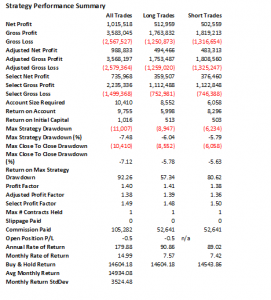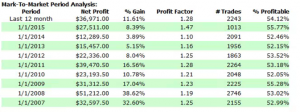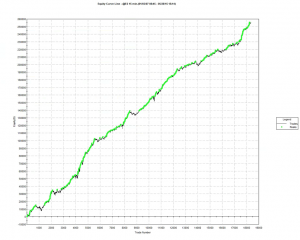Most investors have probably never seen the P&L of a high frequency trading strategy. There is a reason for that, of course: given the typical performance characteristics of a HFT strategy, a trading firm has little need for outside capital. Besides, HFT strategies can be capacity constrained, a major consideration for institutional investors. So it is amusing to see the reaction of an investor on encountering the track record of a HFT strategy for the first time. Accustomed as they are to seeing Sharpe ratios in the range of 0.5-1.5, or perhaps as high as 1.8, if they are lucky, the staggering risk-adjusted returns of a HFT strategy, which often have double-digit Sharpe ratios, are truly mind-boggling.
By way of illustration I have attached below the performance record of one such HFT strategy, which trades around 100 times a day in the eMini S&P 500 contract (including the overnight session). Note that the edge is not that great – averaging 55% profitable trades and profit per contract of around half a tick – these are some of the defining characteristics of HFT trading strategies. But due to the large number of trades it results in very substantial profits. At this frequency, trading commissions are very low, typically under $0.1 per contract, compared to $1 – $2 per contract for a retail trader (in fact an HFT firm would typically own or lease exchange seats to minimize such costs).
Hidden from view in the above analysis are the overhead costs associated with implementing such a strategy: the market data feed, execution platform and connectivity capable of handling huge volumes of messages, as well as algo logic to monitor microstructure signals and manage order-book priority. Without these, the strategy would be impossible to implement profitably.
Scaling things back a little, lets take a look at a day-trading strategy that trades only around 10 times a day, on 15-minute bars. Although not ultra-high frequency, the strategy nonetheless is sufficiently high frequency to be very latency sensitive. In other words, you would not want to try to implement such a strategy without a high quality market data feed and low-latency trading platform capable of executing at the 1-millisecond level. It might just be possible to implement a strategy of this kind using TT’s ADL platform, for example.
While the win rate and profit factor are similar to the first strategy, the lower trade frequency allows for a higher trade PL of just over 1 tick, while the equity curve is a lot less smooth reflecting a Sharpe ratio that is “only” around 2.7.
The critical assumption in any HFT strategy is the fill rate. HFT strategies execute using limit or IOC orders and only a certain percentage of these will ever be filled. Assuming there is alpha in the signal, the P&L grows in direct proportion to the number of trades, which in turn depends on the fill rate. A fill rate of 10% to 20% is usually enough to guarantee profitability (depending on the quality of the signal). A low fill rate, such as would typically be seen if one attempted to trade on a retail trading platform, would destroy the profitability of any HFT strategy.
To illustrate this point, we can take a look at the outcome if the above strategy was implemented on a trading platform which resulted in orders being filled only when the market trades through the limit price. It isn’t a pretty sight.
The moral of the story is: developing a HFT trading algorithm that contains a viable alpha signal is only half the picture. The trading infrastructure used to implement such a strategy is no less critical. Which is why HFT firms spend tens, or hundreds of millions of dollars developing the best infrastructure they can afford.








